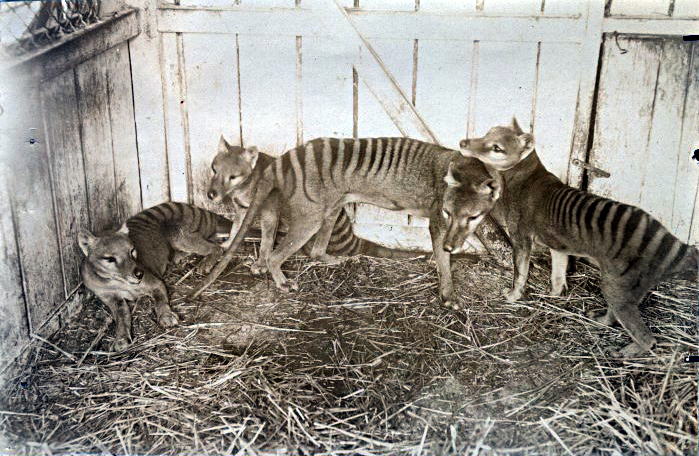Tasmanian Tiger: Difference between revisions
(Added more real life info and sources) |
No edit summary |
||
| Line 34: | Line 34: | ||
* The name "thylacine" is derived from the Greek words ''thýlakos'' meaning "pouch" and ''ine'' meaning "pertaining to", referring to the underbelly pouch marsupials are known for. Interestingly, both males and females had the pouch. | * The name "thylacine" is derived from the Greek words ''thýlakos'' meaning "pouch" and ''ine'' meaning "pertaining to", referring to the underbelly pouch marsupials are known for. Interestingly, both males and females had the pouch. | ||
* The closest living relative is the [[Tasmanian Devil]]. | * The closest living relative is the [[Tasmanian Devil]]. | ||
* The Thylacnine/Tasmanian Tiger is a [https://en.wikipedia.org/wiki/Basal_(phylogenetics) basal] member of the [https://en.wikipedia.org/wiki/Dasyuromorphia Dasyuromorphia | * The Thylacnine/Tasmanian Tiger is a [https://en.wikipedia.org/wiki/Basal_(phylogenetics) basal] member of the [https://en.wikipedia.org/wiki/Dasyuromorphia Dasyuromorphia] family. | ||
* They had an unusual talent of being able to [https://en.wikipedia.org/wiki/File:%22Benjamin%22.jpg open their jaws up to 80 degrees]. | * They had an unusual talent of being able to [https://en.wikipedia.org/wiki/File:%22Benjamin%22.jpg open their jaws up to 80 degrees]. | ||
* Thanks to preserved specimens in private collections and museums, its [https://en.wikipedia.org/wiki/Whole_genome_sequencing whole genome sequence] has been mapped and there are efforts to [https://en.wikipedia.org/wiki/Cloning clone] them and bring them back to life. | * Thanks to preserved specimens in private collections and museums, its [https://en.wikipedia.org/wiki/Whole_genome_sequencing whole genome sequence] has been mapped and there are efforts to [https://en.wikipedia.org/wiki/Cloning clone] them and bring them back to life. | ||
Revision as of 23:59, 10 August 2023
Tasmanian Tiger
| |||
|---|---|---|---|
| タスマニアタイガー | |||
| Character Data | |||
| AKA | Thylacine
| ||
| Romaji | ?
| ||
| Debut | Kemono Friends 3 | ||
| Animal Data | |||
| Scientific Name | Thylacinus cynocephalus
| ||
| Distribution | Australia
| ||
| Diet | Carnivore
| ||
| Avg. Lifespan | 5-7 years
| ||
| Read More | Thylacine
| ||
| Conservation | 
| ||
| Tasmanian Tiger | KF3 | Gallery |
Looking for the Friend of the general Thylacine species? See Thylacine.
Tasmanian Tiger is a type of extinct marsupial Friend based on the last confirmed living thylacine.
Series Appearances
| Media | Role | |
|---|---|---|
In Real Life
The Tasmanian Tiger (Thylacinus cynocephalus) is a type of extinct carnivorous marsupial that was native to the Australian mainland and the islands of Tasmania and New Guinea. They were near extinction throughout most of the range (specifically mainland Australia) by about 2,000 years ago. The introduction of dingoes is the most likely reason, though others include extensive hunting, human encroachment on territory, and climate change.
Descriptions of the Tasmanian Tiger come from preserved specimens, fossil records, skins and skeletal remains, and black and white photographs of the animal, both in captivity and in the wild. It resembled a large, short-haired dog with a stiff tail (similar to a kangaroo's tail). An adult could reach about 100 to 130 cm (39 to 51 in.) long, in addition to a tail of around 50 to 65 cm (20 to 26 in.) and stood at a height of around 60 cm (24 in.) There was slight sexual dimorphism, with the males being larger than females: Males weighed on average 19.7 kilograms (43 lbs.) and females on average weighed 13.7 kilograms (30 lbs.). Its coat was made up of dense but soft fur, featured 15 to 20 distinctive dark stripes across its back, rump and the base of its tail (hence the nickname "tiger"). Coloration varied from light fawn to a dark brown, but all had a cream-colored belly.

They most likely preferred dry eucalyptus forests, wetlands, and grasslands of mainland Australia. Physical proof of the tiger's existence in the mainland came from a body that was discovered in a cave in the Nullarbor Plain in Western Australia in 1990. Carbon dating of the body revealed it to be around 3,000 years old. Meanwhile in Tasmania, it preferred the woodlands of the midlands and coastal regions. The stripes on the body helped with camouflage in the wooded areas. A typical territory range was between 40 and 80 km2 (15 and 31 sq mi). However they were not aggressive with boundaries; groups far too large to be a family unit were sometimes observed together.
There is evidence for at least some year-round breeding, the prime breeding season was winter and spring. Litters of two to four joeys would be carried in the mother's pouch for about three months. Once they left the pouch, the young would remain in the den until they were old enough to hunt. There has only been one successful captive breeding: in the Melbourne Zoo in 1899.
Trivia

- While the Tasmanian Tiger is another name for the Thylacine, they are two similar but separate friends in the Kemono Friends franchise.
- The name "thylacine" is derived from the Greek words thýlakos meaning "pouch" and ine meaning "pertaining to", referring to the underbelly pouch marsupials are known for. Interestingly, both males and females had the pouch.
- The closest living relative is the Tasmanian Devil.
- The Thylacnine/Tasmanian Tiger is a basal member of the Dasyuromorphia family.
- They had an unusual talent of being able to open their jaws up to 80 degrees.
- Thanks to preserved specimens in private collections and museums, its whole genome sequence has been mapped and there are efforts to clone them and bring them back to life.
References
- Wikipedia Page
- Threatened Species: Thylacine – Tasmanian tiger, Thylacinus cynocephalus" (PDF). Parks and Wildlife Service, Tasmania. December 2003. Archived from the original (PDF) on 2 October 2006. Retrieved 22 November 2006.
- Jones, Menna (1997). "Character displacement in Australian dasyurid carnivores: size relationships and prey size patterns". Ecology. 78 (8): 2569–2587. doi:10.1890/0012-9658(1997)078[2569:CDIADC]2.0.CO;2.
- "Shrinking Tasmanian tigers: Resizing an Australian icon". phys.org. Retrieved 19 August 2020.
- Rovinsky, Douglass S.; Evans, Alistair R.; Martin, Damir G.; Adams, Justin W. (2020). "Did the thylacine violate the costs of carnivory? Body mass and sexual dimorphism of an iconic Australian marsupial". Proceedings of the Royal Society B. 287 (20201537). doi:10.1098/rspb.2020.1537. PMC 7482282. PMID 32811303.
- Dixon, Joan. "Fauna of Australia chap.20 vol.1b" (PDF). Australian Biological Resources Study (ABRS). Archived from the original (PDF) on 8 January 2009. Retrieved 22 November 2006.
- Paddle (2000), pp. 228–231


